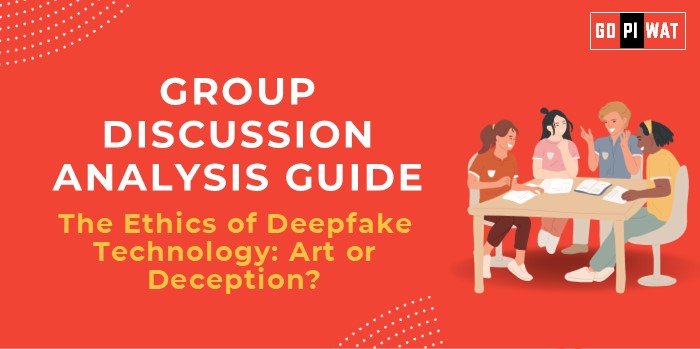📋 Group Discussion (GD) Analysis Guide: The Ethics of Deepfake Technology: Art or Deception?
🌐 Introduction to the Topic
Opening Context: Deepfake technology, leveraging artificial intelligence to manipulate audio, video, and images, has emerged as both a tool for creativity and a source of ethical dilemmas. As its application spans art, entertainment, and misinformation, its ethical implications have garnered global attention.
Topic Background: Deepfakes originated from advancements in generative adversarial networks (GANs), revolutionizing digital content creation. While they empower filmmakers and artists to recreate visuals seamlessly, their misuse in spreading fake news or malicious content raises concerns about societal trust and personal privacy.
📊 Quick Facts and Key Statistics
- 🎥 Launch of GANs (2014): GANs introduced the core technology enabling deepfakes, with creative and deceptive use cases emerging rapidly.
- 🌐 Global Internet Penetration (2024): Over 5.3 billion internet users globally make the spread of deepfake content more impactful.
- 📉 Deepfake Videos Online (2023): Over 90% of deepfake videos were identified as non-consensual explicit content, per Sensity AI.
- 💰 Cost of Fake News (2021): Estimated at $78 billion annually worldwide, highlighting deepfake risks in misinformation campaigns.
👥 Stakeholders and Their Roles
- 🏛️ Government Agencies: Establish regulations to curb misuse while promoting innovation in ethical AI applications.
- 💻 Tech Companies: Develop tools for detecting and countering deepfakes, such as Microsoft’s Video Authenticator.
- 🎨 Creators and Artists: Explore deepfakes as an artistic medium while respecting ethical boundaries.
- 🌍 Society at Large: Be vigilant about the authenticity of digital content.
🏆 Achievements and Challenges
- ✨ Achievements:
- Art and Media Applications: Deepfake technology recreates historic figures or actors for educational and creative projects.
- Efficiency in Film Production: Reduces costs and time through advanced visual effects.
- Assistive AI: Reanimates voices and appearances for speech-impaired individuals.
- ⚠️ Challenges:
- Misinformation and Fake News: Deepfakes complicate trust in media.
- Privacy Violations: Non-consensual use of faces or voices undermines personal dignity.
- Regulatory Gaps: Lack of comprehensive laws across nations to address misuse.
🌍 Global Comparisons
- 🇨🇳 China: Implemented mandatory labeling of AI-generated content.
- 🇪🇺 EU: Focuses on ethical AI guidelines through the Digital Services Act.
📂 Structured Arguments for Discussion
- 💡 Supporting Stance: “Deepfake technology represents a leap in creative possibilities, enabling art forms previously unimaginable.”
- ⚖️ Opposing Stance: “The potential for deepfakes to disrupt democracies and violate personal rights outweighs its artistic benefits.”
- 🔄 Balanced Perspective: “While deepfakes revolutionize content creation, robust ethical and legal frameworks are essential to mitigate their misuse.”
🛠️ Effective Discussion Approaches
- 📊 Opening Approaches:
- Statistical Impact: “With over 90% of deepfake videos being non-consensual, we must question its societal cost.”
- Ethical Questioning: “Does deepfake technology serve art, or does it undermine trust?”
- 🔄 Counter-Argument Handling:
- Acknowledge benefits like artistic use.
- Introduce ethical concerns with privacy and misinformation.
- Propose solutions like digital watermarks or AI-based detection.
🔍 Strategic Analysis of Strengths and Weaknesses
- 💪 Strengths: Breakthroughs in AI and creativity; applications in education and accessibility.
- ⚠️ Weaknesses: Privacy concerns and potential misuse; high barriers to regulating decentralized technology.
- 🚀 Opportunities: Ethical tech development and detection tools; legislative advancements globally.
- ⚡ Threats: Loss of public trust; exploitation by malicious actors.
🏫 Connecting with B-School Applications
- 📌 Real-World Applications: Ethical decision-making frameworks in tech companies; innovative storytelling in marketing, HR, and media.
- ❓ Sample Interview Questions:
- “Should companies like Meta be responsible for deepfake detection?”
- “How can governments balance innovation and regulation in AI?”
- 💡 Insights for B-School Students:
- Understand ethical challenges in tech-driven industries.
- Explore entrepreneurial opportunities in ethical AI tools.


